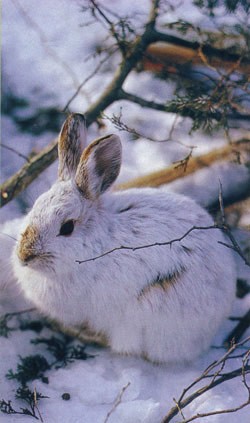
Until a recent study, little was known about the effects of intensive forestry practices on snowshoe hares in northern forests. After studying hare populations following precommercial thinning (PCT), researchers found that this practice, which thins regenerating forests and is used to accelerate stand development, prevents the reestablishment of the complex forest structure that hares need. This study shows that reduced hare numbers persist long after thinning, which is especially significant in Maine, where use of PCT more than doubled from 1990 to 2000, a trend that is paralleled in commercial forests across northeastern North America.
The study, conducted by Jessica Homyack, Daniel Harrison, and William Krohn through the University of Maine, Orono, in 2001 and 2002, focused on the Acadian Forest, the ecoregion between the northern boreal forest and the eastern deciduous forest that covers much of northern New England and the Maritime provinces. The authors were interested in discovering whether PCT reduces hare density more than four years after thinning, which was the length of previous studies. They focused on commercial forests that had been treated with both PCT and aerial herbicides, a combination of practices that the researchers predicted would influence hare habitat the most.
Hares prefer mid-successional forests with high density of saplings. The authors compared 17 stands that had been clearcut, treated with herbicide, and thinned, with 13 untreated stands, which had only been clearcut and treated with herbicide, in six towns in the commercial balsam fir and spruce forests of northern Maine. The goal was to compare the stand-scale effects of PCT on hare density, which they measured by taking pellet counts as an estimate of hare abundance.
The authors found that the effects of PCT led to decreased snowshoe hare densities that persisted 11 years after thinning. Hare densities were reduced by half in the PCT-treated stands, results that the researchers consider representative of large (greater than eight hectares) forest stands.
After PCT, forest understories do not regain the structural complexity that provides thermal protection and cover from predators and is crucial for hare survival, especially during the winter. In addressing issues of land management on commercial timberland in the Acadian Forest in light of this discovery, the authors write that horizontal cover is needed to provide hares with sufficient habitat. They acknowledge that this may involve compromising the economic goals of landowners and urge comparison of PCT to other silvicultural practices, consideration of local conditions, and further research focusing on the landscape scale effects of PCT on hares.

